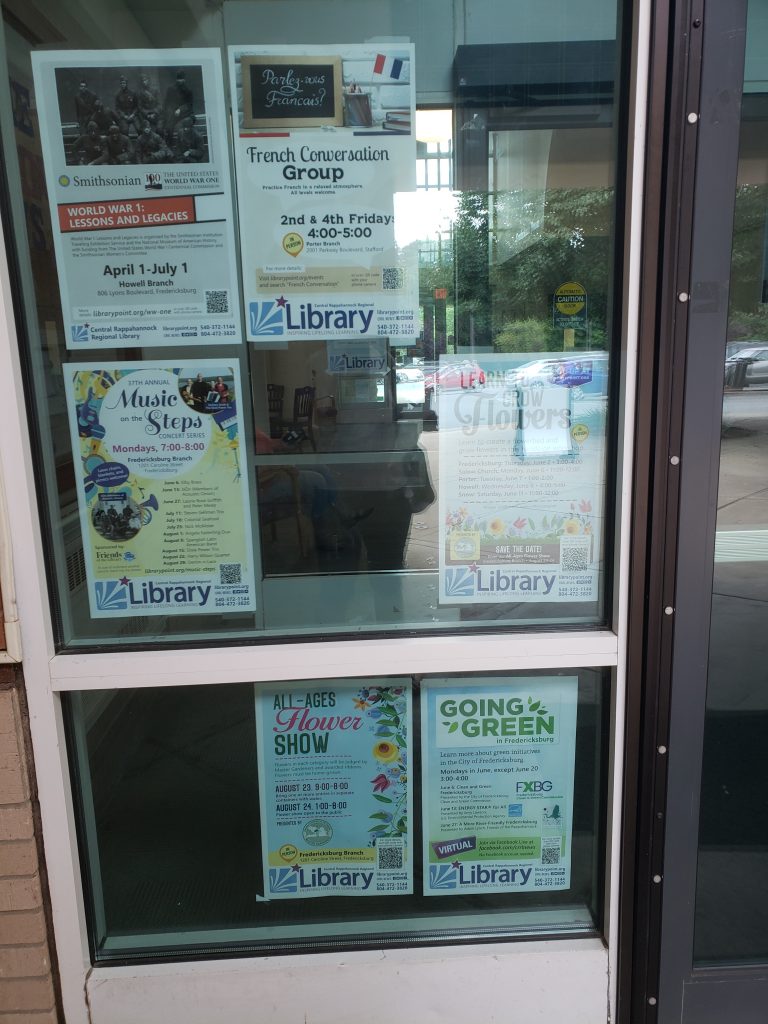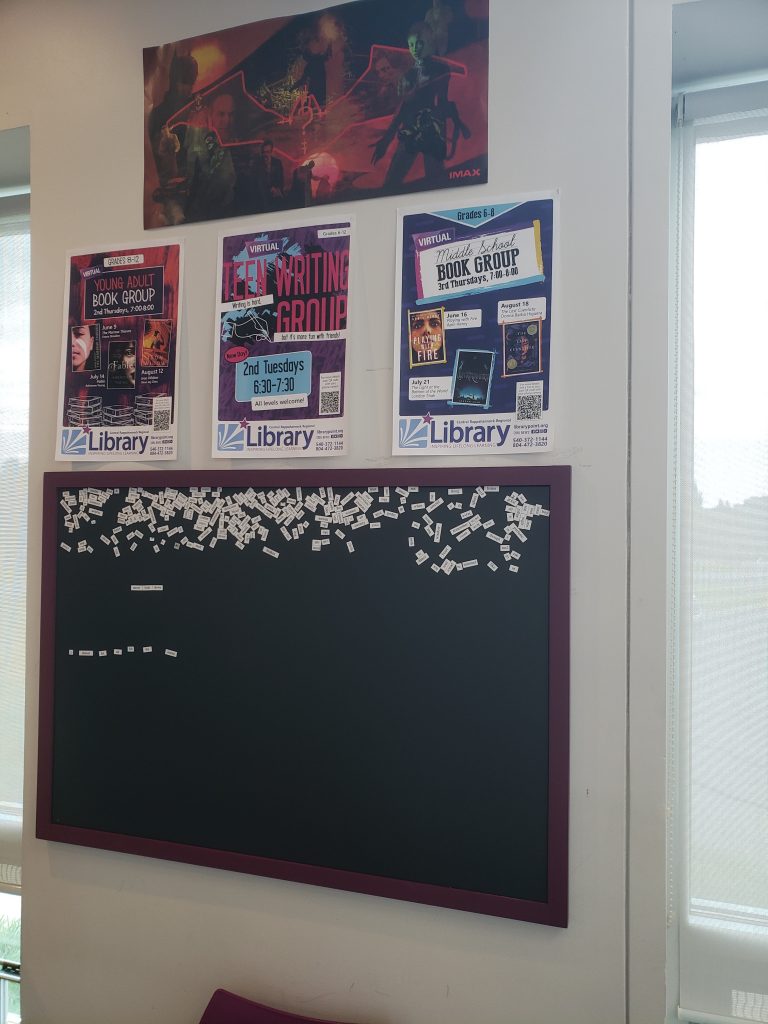I spent some time at a branch of Central Rappahannock Regional Library recently. The Porter Branch is near my home and I have collaborated with them fairly consistently in the context of my job (though I don’t know anyone who works there post-pandemic–time to build new relationships!).
Digital Access
The CRRL website is fairly universal across all branches as far as digital services and the catalog, but there is a dedicated page with information on hours, staffing, and programs specific to each branch. The Porter Library site gives hours, directions, and contact details right up front. Not all of the staff are listed, but the branch manager info is available. Physical services available at the branch and upcoming programs are highlighted, and there is a nice digital carousel of new books and DVDs recently added to their collection.

The Space
This library is located in a residential area right across from an elementary school. My kids and I used to live closer, and we would occasionally walk there since it’s nicely accessible by sidewalk. There are bike and skateboard racks outside, and some nice benches/tables under the trees. It’s very inviting from the outside. They have a drive-through drop box for returns. Programming is evident as oon as you walk into the space (front windows).

Inside, the space is very welcoming and, while older, doesn’t feel outdated. I remember this branch undergoing some renovations a few years ago. There are computers at various heights that allow for direct catalog access, and a bank of computers for public use. They have several meeting and conference rooms in a variety of sizes, from individual up to large group. At the back of the library are study carrels, large tables, and comfortable seating. The shelves are uniform height (not too tall), but there is tiny furniture in the children’s section. They have a room for young children and a dedicated Teen Lounge with computers and a variety of seating. They also have a “friends of the library” used book shop and café right up front. According to the website, the entrances are ADA compliant.
Services and Intellectual Access
The library offers a lot of programming, both virtual and physical. They have posters all over the place advertising various events, primarily posted in the glass at the entrances. They use plexiglass paper holders to designate parts of the collection; fiction is alphabetical by author, with the exception of mystery, which is genrefied. I thought it strange they made this exception, but maybe they did an analysis and saw that was the most popular genre circulating in their library? I found the way the shelving was organized in Fiction to be kind of confusing–the way the alphabet winds isn’t intuitive. Non-fiction is organized by genre, but it used to be Dewey. They reorganized about 5 years ago, if I’m remembering correctly. They have a young children’s section and a YA section. Manga and graphic novels are also shelved separately. According to Rubin & Rubin, “Although encouraging children to read remains a primary objective, children’s services today do much more,” (p.140). This trend is very much apparent in the programming offered by the library.

The catalog is accessible on all computers. I would say there isn’t a lot of diversity evidence, though that doesn’t mean it doesn’t exist. I was surprised their display for P.R.I.D.E month wasn’t bigger (just a single shelf of maybe 10 books).
People
The library clearly welcomes all age groups, with their designated teen and children’s areas. They also have a big Large Print section that makes me think of the elderly, though it would also be for anyone with visual impairment. They offer programs in several languages, and have events for teens, families, adults, children, and the elderly. Some of their online book groups are for English Language Learners. Most of their upcoming programs are either for babies/young children, adults, or the elderly. According to the helpful front desk staff, there are roughly 30 employees. They have a branch manager, a librarian as “department head” for adult and youth services, and in charge of programs. The remaining staff are designated as “customer service” rather than library techs. When I visited the library, there were patrons of all ages and a variety of races looking for books, using the computers, or occupying the workspaces. Interactions with staff seemed positive (as was my own).
Collections
As I previously noted, they have fiction and nonfiction for infants through adult, including YA, manga, and large print. Computers are available and the library also circulates Chromebooks and hotspots for those who may not have reliable internet accessibility at home. They also have a ton of digital books, audiobooks, and research databases or other online services available with a library card. Something I really appreciate as a high school librarian is that CRRL has partnered with our school district to make their e-book collection available to our students through Sora (the Overdrive app for education), even if they don’t have a library card. Our students also have access to their online resources without a library card, as long as they are on school WiFi. While this branch doesn’t circulate any technology beyond Chromebooks and hotspots, CRRL has a Tech-on-the-Go program for those 18 and older that circulates a variety of technology, including video cameras and programmable soundboards. My only complaint based on this observation of their collection is a lack of materials in other languages. They have a section of these books, but I was surprised by the lack of diversity–it was mostly Spanish, with a few French, german, and Arabic. That’s not any better than what I have in my school library! The textbook says “if members of the community cannot obtain library materials that are in their native language or that meet their particular needs, then social justice and human rights are not well served,” (p.117), so I think this is an area they could improve on.
Final Notes
Though probably slightly biased, I love Porter library. I have had quite a number of positive experiences there through work, family, and individual needs. The staff are always helpful, going above and beyond to meet patron needs. The space is versatile and welcoming. The entire Central Rappahannock Regional Library system is everything a library should be. According to Rubin & Rubin, “attitudes of individuals toward the public library are strongly positive,” (p.110), and I can’t think of a time when I ever heard or saw someone disagree.
Rubin, R. E. & Rubin, R. G. (2020). Foundations of library and information science (5th ed.). ALA Neal-Schuman.
This seems like a very nice library. I think that’s great that it is close to elementary school and that patrons can easily walk to it. I also love the fact that they have events in English, Spanish, and French. I think that is really meeting the needs of the community. Based on the online presence and all the posters and signs in the library, I would guess that are really focused on programming. Programming seems to be the more popular use of libraries these days rather than checking out books or research. It seems that they are leaning in to that trend which I think is awesome.
Yes, I’ve been super impressed with the CRRL system. All of their libraries have some unique features, but the staff, collection, and access all seem the same throughout their various branches. I do worry about their financial strength. I know when I talked to the librarian at the Downtown branch he told me that the libraries in Spotsy may not be paying as much into the system as other localities, so I’m guessing that probably causes some discussion among library administrators about equity between branches, especially if some are not pulling their weight monetarily. Library financing is something I know nothing about, but I think it is covered in one of our courses down the road.
It’s interesting that there are skateboard racks! That’s a great idea! I’m impressed that they loan out laptops in addition to hotspots. I wonder how many times you can renew a laptop before you have to return it and check out another one? The Henrico libraries also separate out Mystery from the rest of fiction, but the librarian I worked with hoped that it would be interwoven with the rest of fiction. If their nonfiction is no longer Dewey, do they shelve everything by author name? So you could have a book about the civil war next to a book about checkers based on the name of the author? It sounds like they have a lot of virtual programming – do you think that is a trend that will continue as things have gotten back to more “normal” from the pandemic?
No, they shelve nonfiction by genre. Weird that Henrico did the same thing with Mystery! I do think that virtual programming is here to stay–in combination with in-person stuff. It makes it easier for people to attend, especially if they can’t travel to the library.
Wow, their non-fiction is organized by genre – so interesting! I wonder what kind of reasoning it took to organize it that way. I’d love to see it in person. Do you find it much easier to navigate than Dewey? Great info – thanks so much
I don’t know that it’s necessarily easier to navigate, but I guess it’s more user friendly? I think people like finding books by subject more easily, and just browsing shelves in stead of searching the catalog.
I’d love to see why they made the switch to shelving non-fiction by genre. I’ve done some reading on using “bookstore” style organization in libraries, but I have yet to see it in action. This organization system seems like it’s halfway between traditional library and bookstore and I wonder how it affects user experience.
I think I’d love this library too! It looks like they have a lot of programming . I wonder when they restarted in-person programming? I hope lots of people are coming.